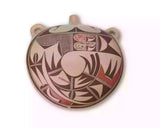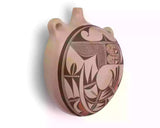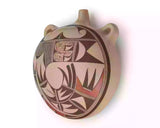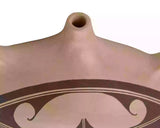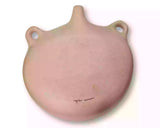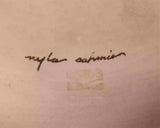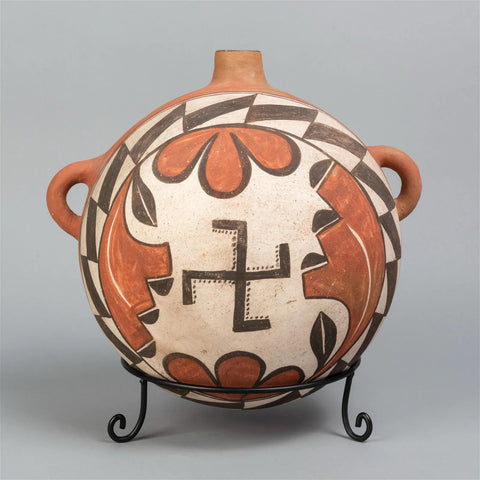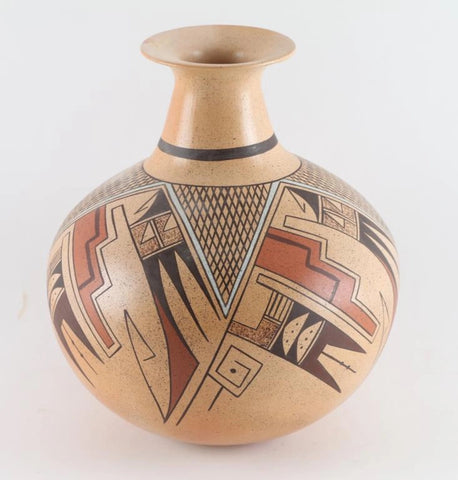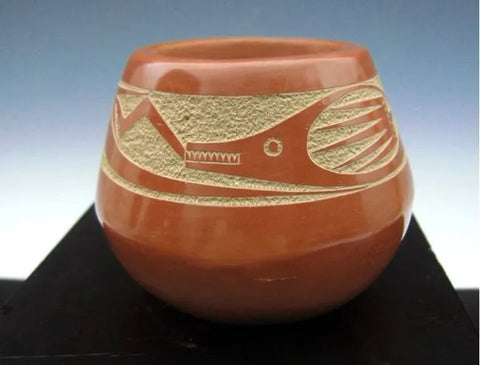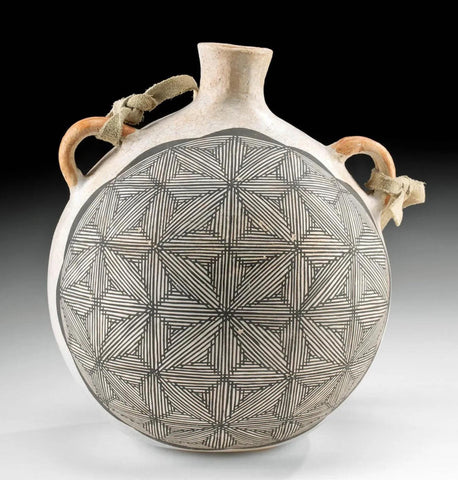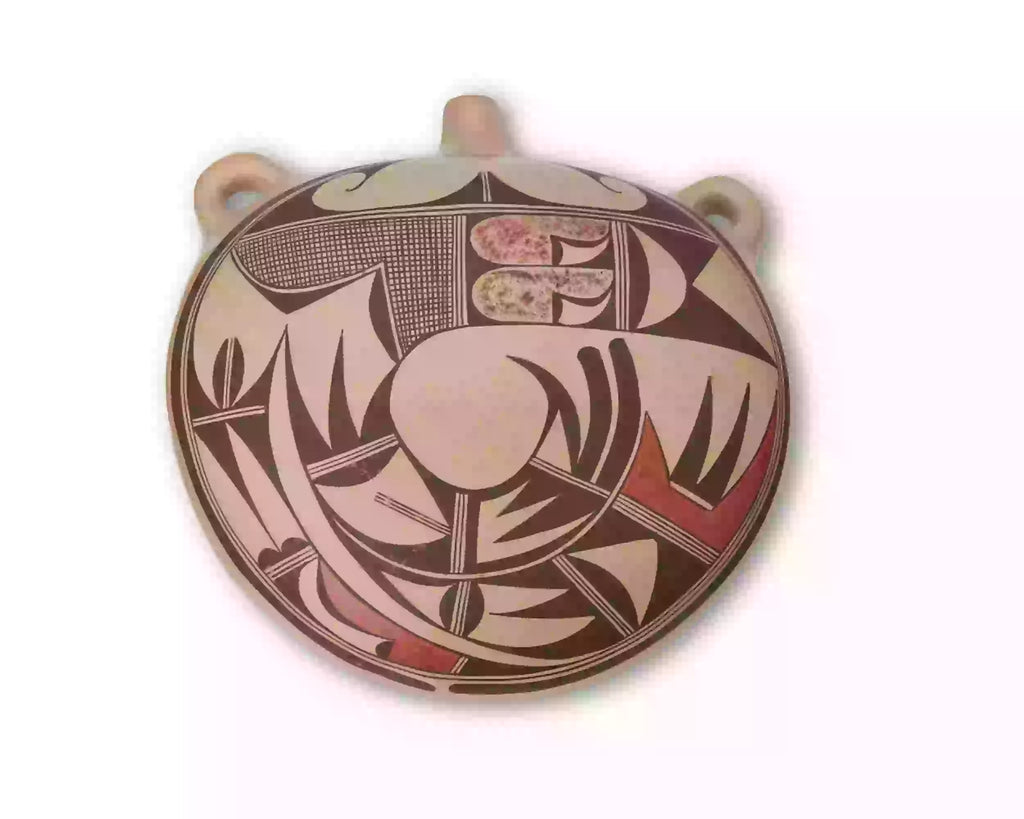
a large Hopi polychrome pottery canteen, late 20th century by Nyla Sahmie, #1780.
$ 2,232.00
Description: #1780, large Hopi polychrome pottery canteen, late 20th century by Nyla Sahmie. The canteen with opposed lug handles and three-color geometric motifs on buff ground.
Dimensions: 10.25" H x 10" W x 5" D
Provenance: Private Collection, Southern California Dreaming
Condition: Overall good condition with shelf wear, scattered minor scuffs, and inherent firing flaws commensurate with age. Scattered crazing to the glaze and localized areas of scratches and scuffs.
"Nyla “Nampeyo” Sahmie, member of the Corn Clan, was born in 1954 into the Hopi Reservation. She was taught the art of constructing Hopi pottery, using ancient traditional methods, passed down to her from her mother, Priscilla Namingha-Nampeyo.
Nyla began experimenting with pottery at the age of 13. She has continued this long lived family tradition just like her ancestors have before her. Her goal is to become one of the finest potters ever just like the famed Nampeyo. Nyla is a fifth generation of Nampeyo potters currently working with clay."
"Nyla specializes in hand coiled yellow-orange traditional pottery. She gathers her clay, grinds it down, cleans the clay, mixes, hand coils, sands, paints her designs, and fires the pottery, outdoors, with sheep dung. Her favorite patterns to paint are: migrations, double hummingbirds, and flowers. She recently has begun to hand coiling very large olla pots. Nyla stated, “Making pottery has come naturally to me and I am honored to be a member of one of the most famous Native American Family names”. She signs her pottery as: Nyla Nampeyo, followed by a corn symbol to denote her Clan origin."
"Nyla currently is working with children at local Elementary Schools and High Schools in her area, educating the youth about the Hopi heritage and culture. She does this so that the tradition of the Hopi ways of life are continued and not forgotten." (Source: Pueblo Direct.com)
“Pueblo pottery is made using a coiled technique that came into northern Arizona and New Mexico from the south, some 1500 years ago. In the four-corners region of the US, nineteen pueblos and villages have historically produced pottery. Although each of these pueblos use similar traditional methods of coiling, shaping, finishing and firing, the pottery from each is distinctive. Various clays gathered from each pueblo’s local sources produce pottery colors that range from buff to earthy yellows, oranges, and reds, as well as black. Fired pots are sometimes left plain and other times decorated—most frequently with paint and occasionally with appliqué. Painted designs vary from pueblo to pueblo, yet share an ancient iconography based on abstract representations of clouds, rain, feathers, birds, plants, animals and other natural world features.
Tempering materials and paints, also from natural sources, contribute further to the distinctiveness of each pueblo’s pottery. Some paints are derived from plants, others from minerals. Before firing, potters in some pueblos apply a light colored slip to their pottery, which creates a bright background for painted designs or simply a lighter color plain ware vessel. Designs are painted on before firing, traditionally with a brush fashioned from yucca fiber.
Different combinations of paint color, clay color, and slips are characteristic of different pueblos. Among them are black on cream, black on buff, black on red, dark brown and dark red on white (as found in Zuni pottery), matte red on red, and poly chrome—a number of natural colors on one vessel (most typically associated with Hopi). Pueblo potters also produce undecorated polished black ware, black on black ware, and carved red and carved black wares.
Making pueblo pottery is a time-consuming effort that includes gathering and preparing the clay, building and shaping the coiled pot, gathering plants to make the colored dyes, constructing yucca brushes, and, often, making a clay slip. While some Pueblo artists fire in kilns, most still fire in the traditional way in an outside fire pit, covering their vessels with large potsherds and dried sheep dung. Pottery is left to bake for many hours, producing a high-fired result.
Today, Pueblo potters continue to honor this centuries-old tradition of hand-coiled pottery production, yet value the need for contemporary artistic expression as well. They continue to improve their style, methods and designs, often combining traditional and contemporary techniques to create striking new works of art.” (Source: Museum of Northern Arizona)
Dimensions: 10.25" H x 10" W x 5" D
Provenance: Private Collection, Southern California Dreaming
Condition: Overall good condition with shelf wear, scattered minor scuffs, and inherent firing flaws commensurate with age. Scattered crazing to the glaze and localized areas of scratches and scuffs.
"Nyla “Nampeyo” Sahmie, member of the Corn Clan, was born in 1954 into the Hopi Reservation. She was taught the art of constructing Hopi pottery, using ancient traditional methods, passed down to her from her mother, Priscilla Namingha-Nampeyo.
Nyla began experimenting with pottery at the age of 13. She has continued this long lived family tradition just like her ancestors have before her. Her goal is to become one of the finest potters ever just like the famed Nampeyo. Nyla is a fifth generation of Nampeyo potters currently working with clay."
"Nyla specializes in hand coiled yellow-orange traditional pottery. She gathers her clay, grinds it down, cleans the clay, mixes, hand coils, sands, paints her designs, and fires the pottery, outdoors, with sheep dung. Her favorite patterns to paint are: migrations, double hummingbirds, and flowers. She recently has begun to hand coiling very large olla pots. Nyla stated, “Making pottery has come naturally to me and I am honored to be a member of one of the most famous Native American Family names”. She signs her pottery as: Nyla Nampeyo, followed by a corn symbol to denote her Clan origin."
"Nyla currently is working with children at local Elementary Schools and High Schools in her area, educating the youth about the Hopi heritage and culture. She does this so that the tradition of the Hopi ways of life are continued and not forgotten." (Source: Pueblo Direct.com)
“Pueblo pottery is made using a coiled technique that came into northern Arizona and New Mexico from the south, some 1500 years ago. In the four-corners region of the US, nineteen pueblos and villages have historically produced pottery. Although each of these pueblos use similar traditional methods of coiling, shaping, finishing and firing, the pottery from each is distinctive. Various clays gathered from each pueblo’s local sources produce pottery colors that range from buff to earthy yellows, oranges, and reds, as well as black. Fired pots are sometimes left plain and other times decorated—most frequently with paint and occasionally with appliqué. Painted designs vary from pueblo to pueblo, yet share an ancient iconography based on abstract representations of clouds, rain, feathers, birds, plants, animals and other natural world features.
Tempering materials and paints, also from natural sources, contribute further to the distinctiveness of each pueblo’s pottery. Some paints are derived from plants, others from minerals. Before firing, potters in some pueblos apply a light colored slip to their pottery, which creates a bright background for painted designs or simply a lighter color plain ware vessel. Designs are painted on before firing, traditionally with a brush fashioned from yucca fiber.
Different combinations of paint color, clay color, and slips are characteristic of different pueblos. Among them are black on cream, black on buff, black on red, dark brown and dark red on white (as found in Zuni pottery), matte red on red, and poly chrome—a number of natural colors on one vessel (most typically associated with Hopi). Pueblo potters also produce undecorated polished black ware, black on black ware, and carved red and carved black wares.
Making pueblo pottery is a time-consuming effort that includes gathering and preparing the clay, building and shaping the coiled pot, gathering plants to make the colored dyes, constructing yucca brushes, and, often, making a clay slip. While some Pueblo artists fire in kilns, most still fire in the traditional way in an outside fire pit, covering their vessels with large potsherds and dried sheep dung. Pottery is left to bake for many hours, producing a high-fired result.
Today, Pueblo potters continue to honor this centuries-old tradition of hand-coiled pottery production, yet value the need for contemporary artistic expression as well. They continue to improve their style, methods and designs, often combining traditional and contemporary techniques to create striking new works of art.” (Source: Museum of Northern Arizona)
Related Products
Sold out

